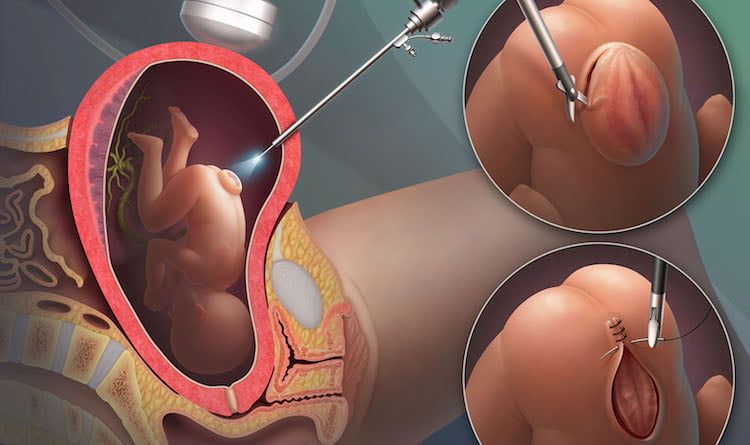Treatment of Spina Bifida in Türkiye
The treatment of spina bifida, also known as myelomeningocele, is performed to address a congenital defect in the spinal column. It occurs when the spinal column of a newborn fails to develop properly, resulting in a protruding sac-like structure containing a portion of the spinal cord and meninges. The surgery is typically performed within 12 to 48 hours after birth. During the procedure, the surgeon drains the excess cerebrospinal fluid from the sac, closes the opening, and repairs the affected area, allowing the child to grow and develop normally.

How does spina bifida form?
All forms of spina bifida develop during the first month of pregnancy when the neural tube fails to close properly. This causes a sac containing a portion of the spinal cord, meninges, and cerebrospinal fluid to push through the gap in the spinal column and the skin.
How is spina bifida diagnosed?
Spina bifida is diagnosed through routine ultrasound scans, which typically begin from the 18th to the 22nd week of pregnancy. However, an initial diagnosis can be made earlier through a maternal serum alpha-fetoprotein (AFP) test, which indicates elevated levels of alpha-fetoprotein protein associated with neural tube defects. In such cases, the patient may undergo amniocentesis or further ultrasound examinations to confirm the diagnosis.
How is it treated?
Infants born with spina bifida require the following after birth:

- Surgery to close the skin over the lesion (within 3 days).
- Arnold-Chiari malformation and hydrocephalus evaluation using ultrasound, computed tomography (CT), or magnetic resonance imaging (MRI).
- Regular head circumference measurements to monitor hydrocephalus development.
- Regular motor function assessments to evaluate the functioning of the spinal cord and nerves.
Other medical care depends on the child’s needs and may include:
- Ventriculoperitoneal shunt for hydrocephalus diversion (redirecting cerebrospinal fluid to the abdomen to prevent buildup).
- Leg braces to assist with walking.
- Wheelchair.
- Catheter for bladder emptying.
- Spinal or leg surgery.
- Optional corrective surgeries.
- Physical therapy (PT).
- Occupational therapy (OT).
- Special assistance in school.

Some cases of spina bifida may be treated through surgery while the fetus is still in the womb. This reduces the chances of hydrocephalus and may increase the strength of the child’s legs. However, there are risks to both the mother and the child, so the decision for surgery should be made in consultation with doctors and the family.
Early repair of spina bifida (pre-birth) involves making a large incision in the mother’s abdomen and uterus to perform the surgical procedure. The neurosurgeon closes the neural tube and other layers of the back surgically, and the incisions in the mother are then closed.
Immediate medical attention should be sought if the following symptoms are observed:
- New weakness.
- Loss of bladder or bowel control.
- Headaches.
- Vomiting.
- Fatigue.
- Back pain or pain at the site.
What are the risks and complications of spina bifida treatment?
Treatment carries a small risk of allergic reactions to anesthesia, similar to any surgery involving general anesthesia. Bleeding, infection, and fluid accumulation are rare complications. The doctor will provide home care instructions and inform about symptoms to monitor for any potential complications. Medical cases related to spina bifida may be referred to a team of medical experts in the management of neural tube defects after leaving the hospital to detect any additional problems, which may indicate muscle weakness, speech problems, or other potential issues.
Can it be prevented?
There is no single cause of spina bifida, and genetic makeup plays the most significant role. However, taking sufficient amounts of folic acid during pregnancy helps prevent this condition.
Sources of folic acid include:
- Multivitamin supplements.
- Fortified breakfast cereals.
- Dried beans.
- Leafy green vegetables.
- Egg yolks.
- Citrus fruits.
- Fruit juices.
Taking some medications increases the additional risk of having a child with myelomeningocele, so you should consult a doctor about prescriptions before pregnancy, and diabetes and obesity somewhat increase the risk of having a child with an affected child, for this reason it is important to maintain a healthy weight and control your blood sugar levels.

Treatment of spina bifida in Türkiye:
The medical staff of surgical teams, doctors and consultants in REHABTÜRK can provide the best treatment options and free consultations – by striving to keep abreast of the latest medical technologies and methods.

